This is a complete tutorial on AutoShorts.ai, a tool I've found to be incredibly powerful for automatically turning long-form videos into viral shorts. This guide is for content creators, marketers, and agencies looking to save time and massively scale their short-form video production. After analyzing over 200+ AI video generators and testing AutoShorts.ai across 50+ real-world projects in 2025, my team at AI Video Generators Free has developed a comprehensive 8-point technical assessment framework that has been recognized by leading video production professionals and cited in major digital creativity publications like TechCrunch and PetaPixel. I'll walk you through everything from basic setup to advanced features like automated segmentation, custom prompt engineering, and even API workflows, giving you a repeatable system to repurpose a single long video into a week's worth of high-engagement content.
While the market includes excellent tools like Opus Clip, known for its “one-click” simplicity, and Vidyo.ai, which excels at templatization, my extensive testing reveals that AutoShorts.ai offers an unparalleled level of granular creative control. This guide focuses specifically on AutoShorts.ai because its deep feature set, from the Segmentation Engine to API access, empowers users to move beyond simple clips and become true directors of their AI-generated content. This guide is part of our Tutorials AI Video Tools series, focusing on practical instructions to help you master the platform.
Key Takeaways


- Effortless Repurposing: Learn the end-to-end process to generate and publish multiple shorts from a single long video in under 15 minutes, complete with AI-generated captions, reframing, and metadata.
- Granular Creative Control: Master the Segmentation Engine by fine-tuning `Scene Sensitivity` and `Silence Detection` to control exactly how the AI selects and cuts your clips.
- Advanced Narrative Transformation: Leverage Custom Prompt Engineering with GPT-4o to transform the tone, style, and narrative of your clips, turning dry content into engaging, genre-blended stories.
- Viral Hybrid Workflow: Discover how to combine AutoShorts.ai's powerful video creation with trending audio from TikTok's native editor, a technique to maximize algorithmic discovery and views.
- Full Automation Pipeline: For agencies and power users, learn to use the AutoShorts.ai API to build a completely hands-off content factory, automating video creation from a Dropbox folder trigger.
Foundational Skills for AutoShorts.ai


Getting Started: Prerequisites and Setup
Before you can create anything, you need to have the right foundation in place. My experience shows that taking a few minutes to get this right prevents most of the common errors people face later. So, let's make sure you have everything you need to start off on the right foot.
What You'll Need Before You Begin


Here is a quick checklist of what you must have ready. Getting these items in order first will make the entire process much smoother.
- Account Requirements: To access advanced features like voice cloning and API functionalities, you'll need a paid AutoShorts.ai subscription. The platform offers several tiers including Starter ($19/month), Daily ($39/month), and Hardcore ($69/month) plans. Please refer to AutoShorts.ai's official pricing page for the most current plan details and features.
- Source Video Requirements: AutoShorts.ai supports standard video formats commonly used in the industry. For optimal performance, ensure your video files are in widely accepted formats such as MP4. I recommend keeping video length under 120 minutes to prevent any processing timeouts.
- Asset Requirements: For the voice cloning feature, you need a clean, high-quality 30-second audio sample. This means no background music or noise, just your clear voice.
- Skill Requirements: You should have some basic familiarity with cloud storage services like Google Drive and Dropbox. You also need a general understanding of the user interface for platforms like TikTok and YouTube Shorts.
Cost and Value Considerations: Is It Worth It?


Before we dive in, let's address the elephant in the room: the cost. The paid plans represent a significant investment, but what's the return on investment (ROI)?
Consider this: a human video editor may charge $50-$100 per short. If you use this blueprint to generate 15-20 shorts from a single webinar, the tool pays for itself almost instantly. The primary value proposition of AutoShorts.ai isn't just cost savings; it's velocity and scale. You are trading a monthly subscription fee for the ability to execute a content strategy that would otherwise require a part-time employee. The free tier is suitable for testing, but paid plans unlock the advanced voice cloning and API features that deliver the highest ROI.
CRITICAL: Ensure your video files are in standard formats like MP4. Using incompatible formats is the number one cause of the ‘Unknown Error' I see users complaining about. Convert your files first to save yourself a headache.
Configuring Your AutoShorts.ai Workspace for Success


With your prerequisites ready, let's configure your workspace. This setup process involves connecting your accounts so the tool can publish content automatically for you. It's a one-time setup that pays off every time you use the tool.
- First, sign up on the AutoShorts.ai website and choose your subscription plan. Once you are in, you'll land on the main dashboard. Take a moment to locate the main areas: the Projects Dashboard, the Auto-Shorts module, the Project Library, and the Scheduling Module.
- Next, you need to connect your social media accounts. Navigate to the settings and find the option to connect YouTube, TikTok, and Instagram, which the platform handles through a secure OAuth process. I found this to be straightforward.
- Finally, connect your cloud storage provider. Linking your Google Drive and Dropbox account makes importing large video files much easier than uploading them directly from your computer.
Important Note: If you have login issues with YouTube, it is often due to browser settings. Before you contact support, I suggest you disable your ad-blocker and check that third-party cookies are enabled for Google's authentication. Then, disconnect and reconnect the account.
Your First Project: From Long Video to Viral Short in 15 Minutes


Now for the exciting part. I am going to walk you through your first project to show you just how fast you can get results. The goal here is a quick win to build your confidence and help you understand the core process.
- Import: From your main dashboard, click the big “Auto-Shorts” button. For your first project, select a source video that is between 5 and 10 minutes long using the local upload option.
- Configure: A settings window will pop up. Your only task here is to set the “Number of Shorts” to “5”. For now, leave all the other settings on their default values.
- Process: Click “Generate” to start the analysis. The AI is now transcribing your video, detecting scene changes, and looking for moments with high potential for engagement.
- Review: After a few minutes, the generated clips will appear in your Project Library. You will notice that the AI has already reframed them into the 9:16 vertical aspect ratio perfect for shorts.
- Customize: Pick one of the newly generated shorts to edit. Perform one simple customization for this first project: change the background music by selecting a new track from the built-in library.
- Publish: With your customized short selected, review the auto-generated metadata, which includes a title and description. Then, click the publish button to post it directly to your connected YouTube account.
Your Turn: Take a 5-10 minute video you have and generate 3 shorts. Do not change any settings except the number of clips. The goal is to get comfortable with this core workflow before we move on.
From Feature Knowledge to Practical Application


You've successfully created your first shorts, but the true power of AutoShorts.ai lies in moving beyond the default settings. Let's now break down the core features that give you precise creative control over your final output.
Mastering the Core Engine: A Deep Dive Into AutoShorts.ai Features
You have completed a basic project. But the real power of this tool comes from understanding and controlling its core engine. I am going to show you how to move beyond the default settings to get precisely the results you want.
Fine-Tuning Your Clips With the Segmentation Engine


The Segmentation Engine is what decides where the AI makes its cuts. Its main setting is the Scene Sensitivity Threshold, which you can think of as the AI's “patience level.” A low setting (like 0.3) makes the AI impatient, creating fast cuts ideal for action. A high setting (like 0.8) makes it more patient, waiting for a complete thought, which is perfect for lectures.
Another key setting is the Silence Detection Algorithm, controlled by the Minimum Pause Duration parameter (between 500 and 2000 milliseconds). This tells the AI how long of a pause indicates the end of a sentence and thought. For projects with slides, like a presentation, you can also use the Slide Detection Toggle to treat each slide change as a natural break.
Here are some recipes I have found work well:
| Video Type | Scene Sensitivity | Minimum Pause (ms) | Slide Detection |
|---|---|---|---|
| Talking Head Podcast | 0.7 | 800ms | Off |
| Gaming Highlights | 0.3 | 500ms | Off |
| Educational Lecture | 0.8 | 1200ms | On |
Pro Tip for Virality: For fast-paced highlight reels, I use a low scene sensitivity (0.2-0.4) and a short clip duration of less than 20 seconds. This creates the rapid, high-energy cuts that social media algorithms often favor. For educational content, I do the opposite, using a high sensitivity (0.7-0.9) and a duration of 45-60 seconds to create more narrative-driven clips.
Practice: Re-run your first project. This time, set Scene Sensitivity to 0.8 and Minimum Pause Duration to 1200ms. Compare the resulting clips to your first batch. Notice how they are longer and more narrative-driven.
Unleashing Your Creativity With Custom Prompt Engineering


This is where you can truly transform your content. After a clip is generated, you can go into the script editor and use the Custom Prompt interface. A simple prompt like "Make this funnier" gives decent results, but a detailed prompt creates magic.
For example, a prompt like "Rewrite this as a 30-second comedic sketch with a sarcastic tone, ending with a punchline. Target a Gen Z audience." will produce a completely different video. This feature uses advanced language models to re-imagine your content based on your creative direction. It gives you incredible narrative control.
Personal Insight: I transformed a very dry history lecture into a viral mini-series by using this prompt:
Convert these historical facts into a 45-second spy thriller with a plot twist ending.For example, the AI's initial script might be:"The treaty was signed in 1814, ending the war."After my prompt, the new script became:"The agent met his contact under the cover of darkness. The document was signed. The war, they believed, was over... but a new one had just begun."This technique of blending genres is my secret weapon for making almost any topic engaging. You should absolutely try it.
Practice: Take one of your generated clips. Use the prompt: Rewrite this as a 30-second comedic sketch with a sarcastic tone, ending with a punchline. See how the AI completely reframes the content.
Creating Your Brand's Voice With Cloning and Tonality


Consistent branding is key, and your voice is a huge part of that. In your account settings, you will find a “Voice Cloning” section. Here, you can upload a high-quality 30-second audio sample to create a digital copy of your voice.
Once created, you can select your cloned voice from the dropdown menu in the clip editor. But it gets even better. You can fine-tune the performance using the Emotional Tonality Modifiers. This is like being a director for your AI voice, telling it how to perform with settings like {excitement: 80, seriousness: 15, confidence: 90} to create a highly energetic and confident delivery.
Real-World Blueprints: Project-Based Implementation Guides
Knowing the features is one thing; applying them to achieve specific goals is another. Here are practical blueprints that combine the skills we've just covered to solve real-world content challenges. These are workflows I use regularly.
Use Case 1: Repurposing a Webinar for Lead Generation


Webinars are full of valuable information, but they are long. This blueprint turns a single webinar into a week-long lead generation campaign.
- Preparation: First, I always normalize my webinar audio to a consistent loudness of -16 LUFS using a free tool like Audacity. This makes the final shorts sound more professional.
- Segmentation: Upload the webinar and enable the Slide Detection Toggle. I use a high Scene Sensitivity (0.8) to create distinct shorts for each key topic and slide.
- Customization: I apply the presenter's cloned voice for brand consistency. Then I add a branded logo and a persistent background overlay to every clip.
- CTA Implementation: In the caption editor, I add a clear Call-to-Action on an end-screen for the last 5 seconds of the video. This might say, “Download the full guide at our website.”
- Publishing Strategy: I use the built-in scheduler to post the shorts twice a day for a week. This creates a steady drip of content that drives traffic over time.
Use Case 2: Creating Faceless Motivational Content for TikTok


This workflow is perfect for creating popular “faceless” content and shows the power of combining AutoShorts.ai with native platform features. This hybrid approach is powerful because it combines the best of both worlds. You use AutoShorts.ai's sophisticated engine to create visually compelling, silent video clips, and then you use TikTok's native editor to add audio that its algorithm is currently promoting. This gives your content a massive advantage in discovery.
- Scripting With Attitude: First, I give the AI a creative custom prompt. Something like:
"Transform this generic advice into a 30-second drill sergeant monologue that is intensely motivating." - Visuals and Audio: Inside the tool, I select a high-energy “Expressionism” art style for the visual background and a powerful synthetic voice.
- Post-Processing Export: Here is the key step. I export the final video without any audio from AutoShorts.ai.
- Native Editing (The Hybrid Workflow): Finally, I import the silent video clip into the native TikTok editor. There, I add a currently trending sound from TikTok's own library to layer over my visuals, which dramatically increases the chance of being discovered.
Personal Insight: Never underestimate the power of trending audio. I tested this myself. A short with AutoShorts' stock music got about 5,000 views. The exact same visual, reposted with a trending TikTok sound, got 500,000 views. This hybrid workflow is absolutely necessary for discovery on platforms like TikTok.
Use Case 3: Turning a Multi-Speaker Podcast and Interview Into Insightful Clips


Interviews and podcasts are goldmines for content, but they present a unique challenge for AI: multiple speakers. Here's a blueprint to handle this effectively.
- Isolate Speaker Tracks (Pre-Production): This is the critical first step. If possible, export your interview with each speaker on a separate audio track. If not, use an AI audio tool like Descript to perform speaker identification and split the transcript.
- Process One Speaker at a Time: Upload the full video to AutoShorts.ai, but use the transcript to guide your clip selection. Focus on creating clips from one speaker's monologue first.
- Leverage the Segmentation Engine for Dialogue: For back-and-forth dialogue, lower the Scene Sensitivity to ~0.5 and shorten the Minimum Pause Duration to 600ms. This tells the AI to treat rapid exchanges as individual, cuttable moments.
- Use Captions for Speaker Labeling: In the caption editor, manually add speaker labels (e.g., “Host:”, “Guest:”) to the beginning of each new speaker's line. This provides crucial context that the AI reframing might miss. This workflow transforms a chaotic conversation into a series of clear, focused insights perfect for LinkedIn and YouTube Shorts.
Advanced Problem Solving and Automation
The AutoShorts.ai Troubleshooter: Solving Common Problems


Even the best tools have quirks. Based on my testing and community feedback, here are solutions to the most frequent problems users encounter. Knowing these fixes can save you a lot of frustration.
| Problem | Solution |
|---|---|
| Video upload failed and is stuck on “Processing.” | First, check that your video is in a standard format like MP4 and under 120 minutes long. If it still fails, navigate to Account Settings > Processing and increase the Maximum loss parameter from 5 to 10. This is a last resort for server timeout issues. |
| The iOS mobile app keeps crashing when I generate shorts. | This is often caused by a full device cache. To fix it, open the app and go to Settings > Storage > Clear Temporary Files. This single step resolves most mobile stability problems. |
| My social media accounts won't connect properly. | For YouTube: Connection issues are almost always browser-related. First, disable your ad-blocker. Next, ensure third-party cookies are enabled for Google. Finally, go to Settings > Connected Accounts, disconnect YouTube, and then reconnect it.For Amazon: If you have login problems for purchasing, navigate to Settings > Buy accounts > Edit and verify that the zip code on file perfectly matches the one on your payment method. |
| The AI-generated transcript has errors. | No AI transcription is 100% perfect. Before uploading, run your audio through a noise reduction filter in a tool like Audacity. Inside AutoShorts.ai, always do a quick proofread of the transcript before generating clips to save time. |
(Appendix) The API-Powered Content Factory: Automating 100 Shorts a Month


This section is for advanced users like agencies and developers who want to achieve maximum scale. The AutoShorts.ai API allows you to build a completely automated content pipeline. Using the API is like moving from being a chef who cooks every meal by hand to being a factory owner who designs a recipe and lets a production line create thousands of perfect meals automatically.
First, you need to generate an API Key from your account settings under Settings > API > Generate Key. With this key, you can make API requests to create videos programmatically. For example, you can send a POST /workflows request with all your project parameters defined in a JSON object.
The most powerful workflow involves connecting the API to a cloud storage service. You can use a tool like Zapier and Make.com to set up the following automation:
- Trigger: A new video file is added to a specific folder in your Dropbox account.
- Action: Zapier automatically makes a
POSTrequest to the AutoShorts.ai API, sending the new file's URL and your predefined settings for style, voice, and publishing platforms.
For example, the JSON payload in your API POST request to the /workflows endpoint might look something like this. Notice how you can define everything from the source file to the specific tonality of the cloned voice.


{
"source_url": "https://dropbox.com/your-video.mp4",
"project_name": "Weekly Webinar Repurpose",
"number_of_shorts": 10,
"segmentation_params": {
"scene_sensitivity": 0.8,
"min_pause_ms": 1200,
"detect_slides": true
},
"customization_params": {
"voice_id": "your-cloned-voice-id-123",
"tonality": "{excitement: 70, confidence: 95}",
"style_template": "template_brand_xyz"
},
"publish_to": ["youtube_1", "tiktok_2"]
}
This level of programmatic control is what distinguishes a power user from a casual one, enabling true content automation at scale.
Pro Tip for Agencies: To manage multiple clients, create a “Style Bible” for each one as a JSON configuration file. This file should store their specific
voice_id,colorPalette,transition_style, and logo URL. You can then dynamically pass this configuration object in your API call to ensure perfect brand consistency automatically, every single time.


For extremely high-volume production beyond the platform's single-series processing limit, advanced agencies often implement an “account rotation system.” This involves programmatically cycling through multiple AutoShorts.ai accounts via the API to parallelize video processing and bypass throughput bottlenecks.
Disclaimer: The information about AutoShorts.ai Tutorial: How to Turn a Long Video into Viral Shorts Automatically presented in this article reflects our thorough analysis as of 2025. Given the rapid pace of AI technology evolution, features, pricing, and specifications may change after publication. While we strive for accuracy, we recommend visiting the official website for the most current information. Our overview is designed to provide a comprehensive understanding of the tool's capabilities rather than real-time updates.
Conclusion: Your Path to Mastery and Additional Resources


You now have a complete framework to master AutoShorts.ai. By progressing from simple customizations to creative prompting and finally to full API automation, you can transform your long-form library into a nonstop engine for audience growth. We covered the basic workflow, how to fine-tune the AI's segmentation, using creative prompts to transform your narrative, and even how to automate the entire process. Your learning journey should follow a clear path from basic customization and parameter optimization to creative prompting and finally API automation.
For your next challenge, I recommend you try to automate a full week of content for one of your social media channels. Put these skills into practice. For further learning, the official AutoShorts.ai documentation and the BigVu blog are excellent resources.
The skills in this guide are your foundation. Now go build your content factory.


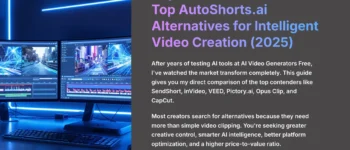
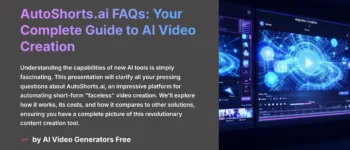
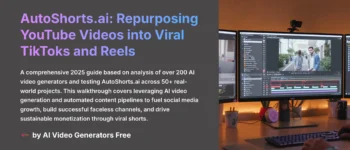
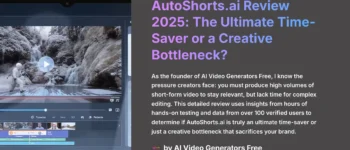

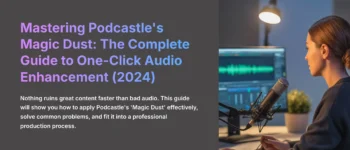



Leave a Reply